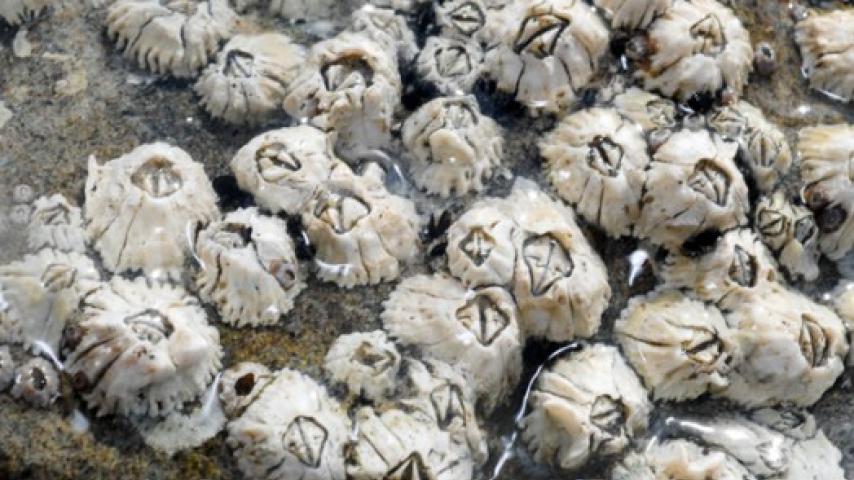Acorn Barnacle (Balanus glandula)
Barnacles are crustaceans, not mollusks! There is a little arthropod—jointed-legged animal—living inside that cone-shaped shell.

KINGDOM Animalia - PHYLUM Arthropoda - CLASS Maxillopoda - ORDER Sessilia - FAMILY Balanidae
It has been written that barnacles stand on their heads and shovel food into their mouth with their legs, and that just about describes them. In fact, the cement glands that adhere them to the substrate are at the base of their first pair of antennae, so it can be said they are attached by their forehead.
The animal is surrounded by a shell that it produces, made up of six plates fused to each other as well as the shell on the substrate. The hole in the top allows the animal to feed, and valves in it can seal it against predators and desiccation.
Because it is fixed in place (sessile), a barnacle has a very different anatomical setup than its motile relatives. The head and thorax show no obvious segmentation, and there is almost no abdomen. The thoracic legs are modified into cirri (singular cirrus), long and feathery and used to filter food from the water. The legs are extended through the opening in the shell and waved through the water repeatedly to capture plankton and move it toward the mouth.
Barnacles have no gills, instead absorbing oxygen through their legs. The feathery legs look enough like gills that this is not entirely surprising. The legs can be pulled into the shell and the shell closed with lightning speed when a shadow, perhaps a predator, passes over the barnacle. The barnacles are more inclined to keep the shell closed when well fed.
Not being able to move, barnacles have adopted an interesting reproductive strategy. Individual acorn barnacles are both male and female at the same time. Breeding occurs when a barnacle extends its penis outside its shell and tests nearby shells until it finds a receptive mate. The organ is then extended into the receptive barnacle’s shell, and fertilization takes place. Barnacles have the longest penises for their body size of any animals.
Larval barnacles settle out in spring in vast numbers, potentially covering exposed substrates. They can reach awe-inspiring population densities of 70,000/square meter at their most abundant. They then compete for space with each other, as well as other sessile rock-dwellers such as anemones and mussels. Each species seems to be adapted for a different tidal height, so barnacle species are zoned above and below each other. Blue mussels are often abundant in the same zone.
This species is most common in the upper mid intertidal zone, less abundant just above and below that zone. Its success is in part attributable to the fact that it can extract oxygen from both water and air, and it is quite resistant to desiccation when the tide is out. Nevertheless, there are other barnacles that outcompete it at both upper and lower limits and probably contribute to setting those limits.
Barnacle predators include snails that drill through the shell, usually at junction points, and starfish such as Ochre Sea Stars that can pull the plates apart and evert their stomach directly into the opening. Other sea stars also use this species as prey, and dog whelks can drill into the shells. Grazing limpets can have a substantial effect on just-settled barnacles, effectively bulldozing them off the substrate.
Last edited 11/16/2020 at 2:57 pm.


